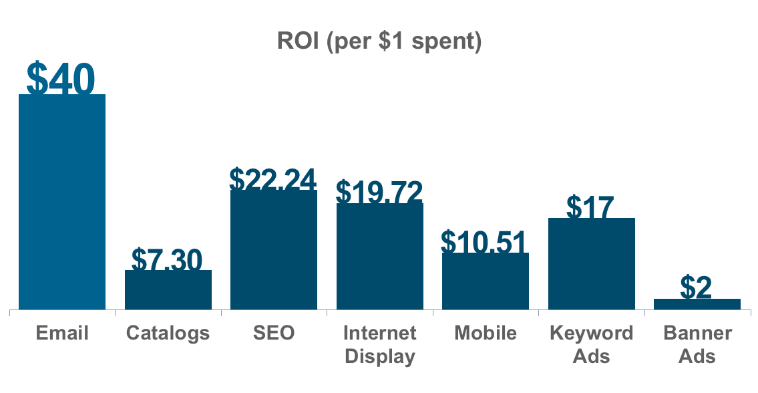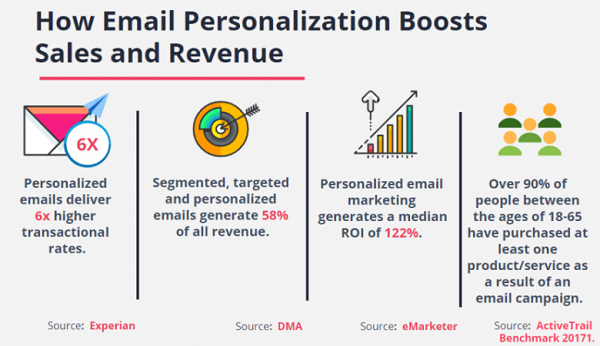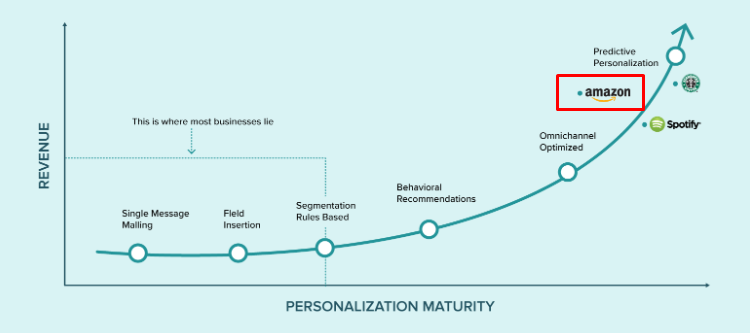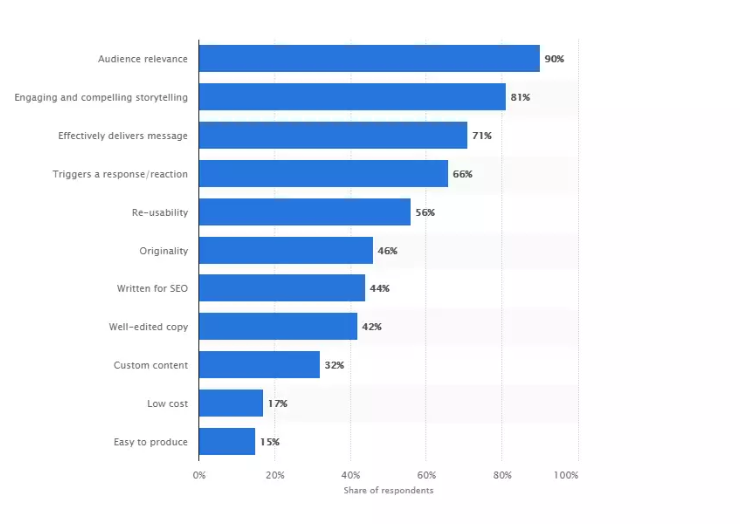In today’s world, there are plenty of channels a brand can use to reach a prospect.
Digital channels are the ones that draw the most attention and a great deal of engagement.
Of course, by “digital channels”, I don’t mean targeted online ads, landing pages (here are some landing page examples to steal, by the way.) or social media platforms alone.
There is also the staple of digital marketing: email marketing, the medium that consistently produces the highest ROI.

(Source)
The statistic above shows how email marketing is the most affordable and rewarding digital channel. Part of email’s staying power comes from its ability to adapt to new marketing trends.
This is why we all need to be up to date with the current email marketing strategies while staying one step ahead of the competition.
A dispatch email deliverability tool is a pivotal software used by businesses and marketers to assess and enhance the successful delivery of their emails to donors’ inboxes.
This tool analyzes colorful factors, including sender character, happy quality, and spam liability, to identify implicit deliverability issues.
By furnishing precious perceptivity and practicable recommendations, it helps businesses increase their dispatch delivery rates, ameliorate engagement, and avoid being flagged as spam, eventually leading to further effective dispatch marketing juggernauts.
Without further ado, let’s check out the email marketing and marketing automation strategies for 2020.
Video In Email Marketing
The trickiest of those email marketing strategies is using video in emails. Not all email clients support video, despite the fact that marketers have been trying to incorporate video in their email marketing endeavors since the late ‘90s.
According to Forrester’s research, “a minute of video is worth 1.8 million words.” It has also been found that a video can lead to a 200-300% increase in email CTR.
How can you apply this to your email campaigns?
Your first option would be to embed a video using HTML5. Unfortunately, few email clients use HTML5, which means they won’t be able to support this.
If you’re using an email platform like Moosend, you can use the video feature that comes in the editor.
Another solution would be to use a static image, a snippet of the video that will make the user click on the image. This is ideal if your image has a “fake” play button on it.
After clicking, the user is redirected to a landing page that contains the video.
You can also insert a GIF into your email. It’s one of the oldest image formats and is supported by most email clients.
It’s important to show the key aspects of your message on the first frame of your GIF because it’s not universally supported.
As you understand, video in email marketing can be hard work. But is it worth it?
According to SuperOffice’s study, including the word “video” in your email subject line can increase open rates by 6%. This will inevitably lead to higher click-through rates and will contribute to your CRO efforts if your content is spot-on.
Another reason why videos in email marketing are worth the trouble is the fact that it can boost engagement and help with your SEO endeavors.
What do I mean by that?
Your video won’t be just included in your email. By adding a “share with a friend” button it will be out there and you’ll be encouraging people to share and spread the word.
If you make content that’s fun and easy to digest, make everything clickable and remove autoplay, you’ll have a fantastic campaign that will be valuable to you and the recipients of your email campaign.
And a little hint here: You can always find a way to reach out to influencers on social media and ask them to share your video as well.
Hyper-Personalization
You can slowly but surely forget about the personalization tips and tricks all of us marketers have used so far.
The techniques we use today, both in email marketing and other channels, aim to enable us to entice prospects and increase metrics like our brand’s MRR.
They also aim to help brands reach the KPIs set at the beginning of each project.
AI is making many best practices obsolete. But what does that mean for email marketing?
An AI platform will be able to go through data quickly and easily, make fewer mistakes than humans, and find patterns in that data.
These patterns will be used by the machine to help it learn and predict preferences and desires to deliver personalized 1-on-1 content without any assistance. It is the definition of WIIFM, showing exactly what the customer is looking for.
We’ve become used to the following steps: develop a buyer persona, implement demographic segmentation, and then personalize. Which is a technique that works really well, but growing consumer needs demand more and more attention.
Actually, consumers nowadays demand to feel special. It’s logical because they likely have dozens of brands fighting for their attention.
The main problem with this tactic is that personas cannot be all people. A persona represents the ideal customer that has XYZ characteristics. This does not mean the ideal customer will only have the five characteristics you need them to have.
Therefore, segmentation has more or less been treating unique prospects like parts of a group, which is something that will produce diminishing returns over time.
This is why we need AI.
AI holds the potential to substantially amplify the effectiveness of digital marketing outreach campaigns. Following AI best practices is paramount to utilizing this advanced technology in a manner that is both productive and moral.
By following the link, you can discover a wealth of creative tactics and methodologies and explore them in detail. After all, the resource offers valuable perspectives on employing AI to customize content, refine automation processes, and boost the overall performance of email initiatives.
Marketers who are well-versed and implement these optimized practices are poised to reap substantial benefits, including elevated levels of engagement and conversions, all while upholding the esteemed reputation of their brand messaging.
Artificial Intelligence, as stated above, will read through the data gathered, identify patterns, and create content that will look and feel (and probably will be, too) tailor-made for each recipient.

(Source)
Artificial Intelligence, as mentioned earlier, meticulously analyzes the collected data, deciphers intricate patterns, and generates content that not only appears and feels custom-crafted but is also uniquely tailored for every individual recipient.
To enhance this AI-driven process, consider utilizing a sophisticated tool like Byword. That tool, known for its intuitive interface and advanced features, can help you refine and polish your content to perfection.
Integrating the analytical capabilities of AI with the precision of Byword can lead to emails that resonate on a deeper level, leading to higher engagement rates and improved results.
The synergy between Artificial Intelligence and Byword marks a new era in email marketing, where technology and creativity converge for remarkable outcomes.
Up until now, it took hours and maybe years of data analysis, a highly skilled copywriter, and constant trial, error, and A/B testing to get one personalized subject line.
Imagine what it takes for a whole email that will lead today’s “evolved consumer” to eventually convert.
But all these don’t fully answer the question: “Why is hyper-personalization going to be a trend in email marketing for 2020?”
The reason is simple: AI can incorporate more than name, income and purchase history into the personalization process.
AI can use behavioral data, real-time triggers, and user history. Eventually, it’ll be able to create tailor-made content that’ll lead users to conversion. From triggered emails with incentives that the user could take advantage of right on the spot, to referral programs that can work by asking the prospect to share your email and earn some extra incentives.
And if you think this is too good to be true…

Content evolution
There will be an increased emphasis on interactive content.
It’s not news because interactive content has been available for quite some time. We’ll see a rise in its use because it’s a great way to make a brand’s emails stand out in a full inbox.
Standing out is not the only objective. Being memorable and having customers that keep coming back, is.
Marketers aim for memorability, virality, and engagement. Email microsites, GIFs, videos, quizzes and many more components that cause users to interact with the content in any way, can boost engagement and will make for a fantastic experience.
Content should be highly personalized. Imagine the engagement rates, when you deliver an email that is personalized and interactive at the same time.
How many curious people will open it and click on its CTAs? I bet plenty. Many will want to play with the content and interact with it. It’s a great idea for all email marketing campaigns
This kind of interactivity and personalization incorporated in storytelling emails, Is what I consider to be the future of email marketing.
Let me explain what I mean: Storytelling is the act incorporating ideas, data, and various information into anything that could make one’s imagination run, resulting in crafting a tale and creating a bond between the brand and the customer.
In simpler words, people receive stories they can relate to better than spreadsheets full of abstract data.

(Source)
Try and craft your email campaigns in a way that you’ll be able to promote storytelling that your target market can relate to.
It will be beneficial for your brand as well because storytelling can show your communication pillars-and true colors.
Go the extra mile by creating a serialized story email campaign.
A video series perhaps, or maybe a gif that will lead to a CTA button: “Login to uncover the full story.” This can have a marked impact on your engagement.
That’s what email will be about in the following years: More engagement, being the one to stand out, and making your brand known by targeting individuals and not segments of a whole.
Final tips
We’ve seen that video, AI, GDPR, and interaction are the four main ingredients when it comes to email marketing in 2020.
The following three components deserve an honorable mention: customer journey maps, UX through marketing automation, and real-time automation.
Customer journey mapping helps marketers and salespeople get a better grasp of the stages a prospect goes through before converting. Understanding the customer journey is one of the prerequisites when you’re crafting an email that will lead you to our second honorable mention:
Improving user experience through marketing automation. A map will help you understand what triggers users’ behaviors.
Through AI data analysis and fantastic content, you’ll be able to enhance the user experience. With some state-of-the-art marketing automation software, you’ll be able to send emails that will be triggered, timely, relevant and that the users will be eager to see.
Finally, real-time email automation, enhanced and centered around the customer’s needs, will continue to reign supreme and offer exactly what your prospects need, exactly when you need it, in 2020.
Takeaway
Of course, we should be expecting to see even more trends. Eventually, all standards will be obsolete and all bets will be off, which is the natural order of all things.
With so many options out there, the only real email marketing strategy is also its real objective: Stand out, be memorable, create experiences through engagement.
Copywriter-turned-content expert, Téa Liarokapi is one of the content writers of the email marketing software company, Moosend, and an avid researcher of all things email and all things marketing. In her free time, she tries to find new ways to stuff more books in her bookcase and content ideas-and cats-to play with
Curious – how do we reach out to become a guest writer? I’m an subject matter expert in upgrading your video call lighting and audio, as well as making videos for businesses.